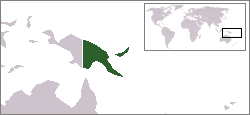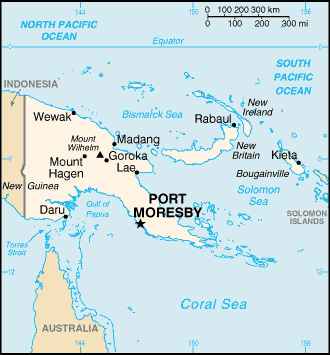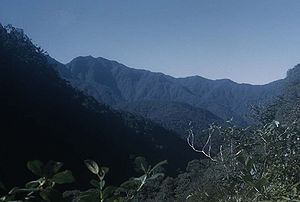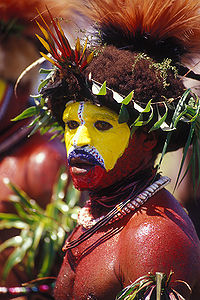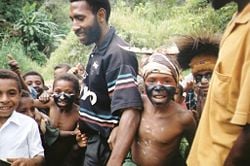Papua New Guinea
| Papua New Guinea Papua Niugini |
||||||
|---|---|---|---|---|---|---|
|
||||||
| Motto: Unity in Diversity | ||||||
| Anthem: O Arise, All You Sons |
||||||
| Capital (and largest city) | Port Moresby 9°30′S 147°07′E | |||||
| Official languages | English, Tok Pisin, Hiri Motu | |||||
| Government | Constitutional monarchy | |||||
| Independence | ||||||
| Area | ||||||
| - | Total | 462,840 km² (53rd) 178,703 sq mi |
||||
| - | Water (%) | 2 | ||||
| Population | ||||||
| - | July 2005 estimate | 5,545,268 (106th) | ||||
| GDP (PPP) | 2005 estimate | |||||
| - | Total | $13.32 billion (132nd) | ||||
| - | Per capita | $2,400 (171st) | ||||
| Currency | Kina (PGK) |
|||||
| Time zone | AEST (UTC+10) | |||||
| - | Summer (DST) | not observed (as of 2005) (UTC+10) | ||||
| Internet TLD | .pg | |||||
| Calling code | +675 | |||||
The Independent State of Papua New Guinea (informally, Papua New Guinea or PNG) is a country in Oceania, occupying the eastern half of the island of New Guinea and numerous offshore islands (the western portion of the island is occupied by the Indonesian provinces of Papua and West Irian Jaya). It is located in the southwestern Pacific Ocean, in a region defined since the early 19th century as Melanesia. Its capital, and one of its few major cities, is Port Moresby. It is one of the most diverse countries on Earth, with over 700 indigenous languages and at least as many indigenous societies, out of a population of just over 5 million. It is also one of the most rural, with only 18 per cent of its people living in urban centres.[1]
The majority of the population live in indigenous societies and practise subsistence-based agriculture. These societies and clans have some explicit acknowledgement within the nation's constitutional framework. The PNG Constitution (Preamble 5(4)) expresses the wish for traditional villages and communities to remain as viable units of Papua New Guinean society[2], and for active steps to be taken in their preservation. The PNG legislature has enacted various laws in which a type of tenure called "customary land title" is recognised, meaning that the traditional lands of the indigenous peoples have some legal basis to inalienable tenure. This customary land notionally covers most of the usable land in the country (some 97% of total land area)[3]; alienated land is either held privately under State Lease or is government land. There is no freehold (also known as fee simple) in Papua New Guinea.
The country's geography is similarly diverse and, in places, extremely rugged. A spine of mountains runs the length of the island of New Guinea, forming a populous highlands region. Dense rainforests can be found in the lowland and coastal areas. This terrain has made it difficult for the country to develop transportation infrastructure. In some areas, planes are the only mode of transport. After being colonized by three external powers since 1888, Papua New Guinea gained its independence from Australia in 1975.
History
Human remains have been found on New Guinea which have been dated to ca. 50,000 years ago. These ancient inhabitants probably had their origins in Southeast Asia. Agriculture was independently developed in the New Guinea highlands around 9,000 years ago, making it one of the few areas of original plant domestication in the world. A major migration of Austronesian speaking peoples came to coastal regions roughly 2,500 years ago, and this is correlated with the introduction of pottery, pigs and certain fishing techniques. More recently, some 300 years ago, sweet potato entered New Guinea having been introduced to the Moluccas from South America by the then-locally dominant colonial power, Portugal. The far higher crop yields from sweet potato gardens radically transformed traditional agriculture; sweet potato largely supplanted the previous staple, taro, and gave rise to a significant increase in population in the highlands.
Little was known in the West about the island until the 19th Century, although European explorers had encountered it as early as the 16th century. The country was named in the 19th century: the word "Papua" is derived from a Malay word describing the frizzy Melanesian hair, and "New Guinea" (Nueva Guinea) was the name coined by the Spanish explorer Yñigo Ortiz de Retez, who in 1545 noted the resemblance of the people to those he had earlier seen along the Guinea coast of Africa.
The northern half of the country came into German hands in the late 19th Century as German New Guinea. During World War I, it was occupied by Australia, which had begun administering the southern part as Papua (formerly British New Guinea) in 1905. After World War I, Australia was given a mandate to administer the former German New Guinea by the League of Nations. Papua, by contrast, was deemed to be an External Territory of the Australian Commonwealth, though as a matter of law it remained a British possession, an issue which had significance for the country's post-Independence legal system after 1975. This difference in legal status meant that Papua and New Guinea had entirely separate administrations, both controlled by Australia.
The two territories were combined into the Territory of Papua and New Guinea after World War II, and later simply referred to as "Papua New Guinea". The Administration of Papua was now also open to United Nations oversight. However, certain statutes continued (and continue) to have application only in one of the two Territories, a matter considerably complicated today by the adjustment of the former boundary among contiguous provinces with respect to road access and language groups, so that such statutes apply on one side only of a boundary which no longer exists.
Independence from Australia occurred in September of 1975. A secessionist revolt which claimed 20,000 lives raged on the island of Bougainville from 1988 until it was resolved in 1997. Autonomous Bougainville recently elected Joseph Kabui as president.
Law
Parliament enacts legislation in the same manner as in other jurisdictions having “cabinet,” “responsible government,” or “parliamentary democracy”: it is introduced by the executive government to the legislature, debated and, if passed, becomes law when it receives royal assent by the Governor-General. Most legislation is actually regulation implemented by the bureaucracy under enabling legislation previously passed by Parliament. All ordinary statutes enacted by Parliament must be consistent with the Constitution and the courts have jurisdiction to rule on the constitutionality of statutes, both in disputes before them and on a reference where there is no dispute but only an abstract question of law.
The "underlying law" — that is, the common law of Papua New Guinea — consists of English common law as it stood at 16 September 1975 (the date of Independence), and thereafter the decisions of PNG’s own courts. The courts are directed to take note of the "custom" of traditional communities, with a view to determining which customs are common to the whole country and may be declared also to be part of the underlying law. In practice, this has proved extremely difficult and has been largely neglected. Statutes are largely adopted from overseas jurisdictions, primarily Australia and England. Advocacy in the courts follows the adversarial pattern of other common law countries.
Politics
Template:Politics of Papua New Guinea
Papua New Guinea is a member of the Commonwealth of Nations and Queen Elizabeth II is the head of state. She is represented in Papua New Guinea by the Governor-General who is currently Sir Paulias Matane.
Actual executive power lies with the Prime Minister, who heads the cabinet. The unicameral National Parliament has 109 seats, of which 20 are occupied by the governors of the 20 provinces. Candidates for members of parliament are voted upon when the prime minister calls a national election, a maximum of five years after the previous national election. In the early years of independence, the instability of the party system led to frequent votes of no-confidence in Parliament with resulting falls of the government of the day and the need for national elections, in accordance with the conventions of parliamentary democracy. In recent years, successive governments have passed legislation preventing such votes sooner than 18 months after a national election. This has arguably resulted in greater stability though, perhaps, at a cost of reducing the accountability of the executive branch of government.
Elections in PNG attract large numbers of candidates. Since independence in 1975, members have been elected by the first past the post system, with winners frequently gaining less than 15% of the vote. Electoral reforms in 2001 introduced the Limited Preferential Vote system (LPV), a version of the Alternative Vote. The first general election to be conducted using LPV will be held in 2007.
Provinces
It was originally considered that Papua New Guinea should be a unitary, as opposed to federal, state. However, a rebellion in the District of Bougainville in 1975 immediately before the granting of independence raised the prospect of the richest District of the country, whose Bougainville Copper Mine was the source of a major part of the Gross National Product, violently departing and leaving the newly independent country vastly more impoverished. As a concession to the Bougainville nationalists, a form of provincial government was offered; subsequently, this was also conferred on the other 18 districts of the country — making a total of nineteen provinces plus the National Capital District. However, the state is not federal: the provinces are creatures of the central government, rather than the central government being the creature of the provinces as in a federation — their constitutional position is closer to that of the provinces of Pakistan and states of India than those of Canada, Australia and the United States — and provincial governments are subject to suspension by the central government. There have been numerous suspensions of provincial governments on the grounds of the corruption or incompetence of elected provincial leaders. As a means of countering the decentralising impetus of constitutional development from the time of Independence, and returning immediate control of the provinces to the central government, the separately elected provincial premierships were abolished and replaced by "governors" who are also members of the National Parliament. An exception is Bougainville, whose constitutional arrangements are unique (see above, "History").
Several provincial governments have purported to change the names of their provinces; such changes remain unofficial as the names contemplated by the Constitution have not been altered through the procedures of constitutional amendment. The provinces are as follows:
|
|
|
|
Geography
Papua New Guinea is mostly mountainous (highest peak: Mount Wilhelm at 4,509 m; 14,793 ft) and covered with rain forest, though there are small plains along the coast. The country is situated along a fault line, making earthquakes and the resultant tsunamis relatively common.
Papua New Guinea is one of the regions closest to the equator that experience snowfall, which occurs in the elevated regions.
The largest area of the country is on New Guinea where the largest cities are also located, including the capital Port Moresby, Lae and Mount Hagen; major islands belonging to Papua New Guinea include New Ireland, New Britain, and Bougainville.
Ecology
PNG is part of the Australasia ecozone, which also includes Australia, New Zealand, eastern Indonesia, and several Pacific island groups, including the Solomon Islands and Vanuatu.
Geologically, the island of New Guinea is a northern extension of the Indo-Australian tectonic plate, forming part of a single landmass Australia-New Guinea (also called Sahul or Meganesia). It is connected to the Australian segment by a shallow continental shelf across the Torres Strait, which in former ages had lain exposed as a land bridge — particularly during ice ages when sea levels were lower than at present.
Consequently, many species of birds and mammals found on New Guinea have close genetic links with corresponding species found in Australia. One notable feature in common for the two landmasses is the existence of several species of marsupial mammals, including some kangaroos and possums, which are not found elsewhere.
Many of the other islands within PNG territory, including New Britain, New Ireland, Bougainville, the Admiralty Islands, the Trobriand Islands, and the Louisiade Archipelago, were never linked to New Guinea by land bridges, and they lack many of the land mammals and flightless birds that are common to New Guinea and Australia.
Australia and New Guinea are portions of the ancient supercontinent of Gondwana, which started to break into smaller continents in the Cretaceous era, 130-65 million years ago. Australia finally broke free from Antarctica about 45 million years ago. All the Australasian lands are home to the Antarctic flora, descended from the flora of southern Gondwana, including the coniferous podocarps and Araucaria pines, and the broadleafed southern beech (Nothofagus). These plant families are still present in Papua New Guinea.
As the Indo-Australian Plate (which includes landmasses of India, Australia, and the Indian Ocean floor in-between) drifts north, it collides with the Eurasian Plate, and the collision of the two plates pushed up the Himalayas, the Indonesian islands, and New Guinea's Central Range. The Central Range is much younger and higher than the mountains of Australia, so high that it is home to rare equatorial glaciers. New Guinea is part of the humid tropics, and many Indomalayan rainforest plants spread across the narrow straits from Asia, mixing together with the old Australian and Antarctic floras.
PNG includes a number of terrestrial ecoregions:
- Admiralty Islands lowland rain forests
- Central Range montane rain forests
- Huon Peninsula montane rain forests
- Louisiade Archipelago rain forests
- New Britain-New Ireland lowland rain forests
- New Britain-New Ireland montane rain forests
- Northern New Guinea lowland rain and freshwater swamp forests
- Northern New Guinea montane rain forests
- Solomon Islands rain forests (includes Bougainville and Buka)
- Southeastern Papuan rain forests
- Southern New Guinea freshwater swamp forests
- Southern New Guinea lowland rain forests
- Trobriand Islands rain forests
- Trans Fly savanna and grasslands
- Central Range sub-alpine grasslands
Economy
Papua New Guinea is richly endowed with natural resources, but exploitation has been hampered by rugged terrain, the high cost of developing infrastructure, serious law and order problems and the system of land title, which makes identifying the owners of land for the purpose of negotiating appropriate agreements problematic. Agriculture provides a subsistence livelihood for 85% of the population. Mineral deposits, including oil, copper, and gold, account for 72% of export earnings. Former Prime Minister Sir Mekere Morauta tried to restore integrity to state institutions, stabilize the kina, restore stability to the national budget, privatize public enterprises where appropriate, and ensure ongoing peace on Bougainville. The Morauta government had considerable success in attracting international support, specifically gaining the backing of the IMF and the World Bank in securing development assistance loans. Significant challenges face the current Prime Minister Sir Michael Somare, including gaining further investor confidence, continuing efforts to privatize government assets, and maintaining the support of members of Parliament. The third quarter (September, 2004) Reserve Bank Report by the Governor of Bank of PNG showed positive economic stance by the Government, with inflation at zero.
Land tenure
Only some three per cent of the land of Papua New Guinea is alienated; it is privately held under 99 year State Lease, or it is held by the State. There is virtually no freehold title; the few existing freeholds are automatically converted to State Lease when they are transferred between vendor and purchaser. Unalienated land is owned under customary title by traditional landowners. The precise nature of the seisin varies from one culture to another, but generally title is communal and in the hands of traditional clans. This is a matter of vital importance because a problem of economic development is identifying who the membership of customary landowning groups is, and thus who the owners are. Disputes between mining and forestry companies and landowner groups often devolve on the issue of whether the companies entered into contractual relations for the use of land with the true owners. Customary property — usually land — cannot be devised by will; it can only be inherited according to the custom of the deceased's people.
Demographics
All three major ethnic groups in the Pacific Ocean, Melanesians, Micronesians and Polynesians, are represented in Papua New Guinea. Chinese, Europeans, Australians, Filipinos, Sri Lankans and Indians also reside in the country.
There are three official languages for Papua New Guinea, in addition to over 700 indigenous non-Austronesian (or Papuan) and Austronesian languages (an incredible ten per cent of the world's total languages). English is an official language, although few people speak it. Many people — mostly on the "New Guinea side," that is, the northern half of mainland PNG and the New Guinea Islands — speak the creole language New Guinea Pidgin ("Tok Pisin" in Pidgin and referred to in English by linguists but not ordinary Pidgin speakers by that name) as a lingua franca. (Much of the debate in Parliament and many newspapers is conducted in Tok Pisin.) In the southern region of Papua, people may use the third official language, Hiri Motu, rather than Tok Pisin which is largely unknown outside Port Moresby, where it has become increasingly common with the influx in recent years of Pidgin-speaking highlanders. With an average of only 7000 speakers per language, Papua New Guinea has a greater density of languages than any other nation on earth except Vanuatu. See the SIL Ethnologue for more information on the diverse range of languages.
About one third of the population adheres to indigenous beliefs. Many of these also claim to be Christian, while two thirds claim only to be Christians. About one third of Christians are Roman Catholic, while the remainder are divided among several Protestant denominations.
PNG has the highest incidence of HIV and AIDS in the Pacific region and is the fourth country in the Asia Pacific region to fit the criteria for a generalised HIV/AIDS epidemic. [4]
Culture
The culture of Papua New Guinea is many-sided and complex. It is estimated that more than a thousand different cultural groups exist in PNG. Because of this diversity, many different styles of cultural expression have emerged; each group has created its own expressive forms in art, dance, weaponry, costumes, singing, music, architecture and much more.
Most of these different cultural groups have their own language. People typically live in villages that rely on subsistence farming. To balance their diets, they go hunting and collect wild plants (such as yams roots) for food. Those who become skilled at hunting, farming and fishing earn a great deal of respect.
On the Sepik River, a group of indigenous people is known for their wood carvings. They create forms of plants or animals, because they believe these are their ancestors.
Sea shells are no longer the currency of Papua New Guinea, as they were in some regions — sea shells were abolished as currency in 1933. However, this heritage is still present in local customs; in some cultures, to get a bride, a groom must bring a certain number of golden-edged clam shells[5] as a brideprice. In other regions, brideprice is paid in lengths of shell bead money, pigs, cassowaries and cash; elsewhere, brideprice is unknown and it is brides who must pay dowry.
People of the highlands engage in colorful local rituals that are called "sing sings". They paint themselves, and dress up with feathers, pearls and animal skins to represent birds, trees or mountain spirits. Sometimes an important event, such as a legendary battle, is enacted at such a musical festival. (See also Music of Papua New Guinea.)
Sport is an important part of PNG culture. At national and international levels, PNG has particularly strong teams in Australian rules football (including the second most players of any country in the world), Soccer, Rugby Union and Rugby league, which is considered the national sport.
Religion
The courts and government practice uphold the constitutional right to freedom of speech, thought, and belief, and no legislation to curb those rights has been adopted, though Sir Arnold Amet, the immediately previous Chief Justice of Papua New Guinea and an outspoken proponent of Pentecostal Christianity, frequently urged legislative and other curbs on the activities of Muslims in the country.
The 2000 census showed 96 percent of citizens were members of a Christian church; however, many citizens combine their Christian faith with some pre-Christian traditional indigenous practices. The census percentages were as follows:
- Roman Catholic Church (27.0%)
- Evangelical Lutheran Church of Papua New Guinea (19.5%)
- United Church (11.5%)
- Seventh-day Adventist Church (10.0%)
- Pentecostal (8.6%)
- Evangelical Alliance (5.2%)
- Anglican Church of Papua New Guinea (3.2%)
- Baptist (2.5%)
- Salvation Army (0.2%)
- Other Christian (8.0%) [6]
Minority religions include the Jehovah's Witness (20,000 or 0.004%), Church of Christ (20,000 or 0.004%), Bahá'í Faith (15,000 or 0.003%) and Islam (1,000 to 2,000 Muslims or 0.0004%, largely foreign residents of African and Southeast Asian origin, but with some Papua New Guinean converts in the towns). Non-traditional Christian churches and non-Christian religious groups are active throughout the country. The Papua New Guinea Council of Churches has stated that both Muslim and Confucian missionaries are active, and foreign missionary activity in general is high.
Traditional religions were often animist and some also tended to have elements of ancestor worship though generalisations are invidious given the extreme heterogeneity of Melanesian societies. For a discussion of one (West Papuan) society's traditional religion by way of example, see the article on the Korowa of Papua.
ReferencesISBN links support NWE through referral fees
- ↑ World Bank (2003). World Bank data on urbanisation. Retrieved 2005-07-15.
- ↑ Constitution of Independent State of Papua New Guinea (consol. to amendment #22). Pacific Islands Legal Information Institute. Retrieved 2005-07-16.
- ↑ Customary Land Tenure in Papua New Guinea: Status and Prospects. Lynne Armitage paper, Queensland University of Technology. Retrieved 2005-07-15.
- ↑ HIV/AIDS in Papua New Guinea. Australia's Aid Program (AusAID). Retrieved 2005-12-16.
- ↑ Papua New Guinea - culture. Datec Pty Ltd. Retrieved 2005-12-16.
- ↑ History Catholic Church in PNG. Retrieved 2006-03-23.
Miscellaneous topics
- Hubert Murray
- Airlines of Papua New Guinea
- Category:Education in Papua New Guinea
- Communications in Papua New Guinea
- Foreign relations of Papua New Guinea
- List of cities in Papua New Guinea
- List of Papua New Guineans
- Military of Papua New Guinea
- Tourism of Papua New Guinea
- Transportation in Papua New Guinea
- University of Papua New Guinea
- Divine Word University
- Awards system of Papua New Guinea
- The Scout Association of Papua New Guinea
Miscellaneous
Papua New Guinea has 572 airstrips.
External links
- Papua New Guinea Government Online
- A newsletter dealing with news and gossip about PNG
- Jane's Papua New Guinea Home Page
- Interactive maps of Papua New Guinea
- Port Moresby Anglican Diocese Web Site
- Trevor's Papua New Guinea Information Pages
- Summer Institute of Linguistics site on languages of PNG
Template:Pacific Islands
an:Papua y Nueba Guinea id:Papua Nugini bg:Папуа-Нова Гвинея zh-min-nan:Papua Sin Guinea ca:Papua Nova Guinea cs:Papua-Nová Guinea da:Papua Ny Guinea de:Papua-Neuguinea et:Paapua Uus-Guinea el:Παπούα Νέα Γουινέα es:Papúa Nueva Guinea eo:Papuo-Nov-Gvineo eu:Papua Ginea Berria fr:Papouasie-Nouvelle-Guinée gl:Papúa Nova Guinea ko:파푸아 뉴기니 hr:Papua Nova Gvineja ilo:Papua Baro a Guinea io:Papua Nov-Guinea is:Papúa Nýja-Gínea it:Papua Nuova Guinea he:פפואה גינאה החדשה ks:पपुवा न्यू गिनी la:Papua Nova Guinea lv:Papua-Jaungvineja lt:Papua Naujoji Gvinėja li:Papoea-Nui-Guinea hu:Pápua Új-Guinea ms:Papua New Guinea nl:Papoea-Nieuw-Guinea nds:Papua-Niegguinea ja:パプアニューギニア no:Papua Ny-Guinea nn:Papua Ny-Guinea oc:Papoa Nòva Guinèa pl:Papua-Nowa Gwinea pt:Papua-Nova Guiné ro:Papua Noua Guinee ru:Папуа — Новая Гвинея sa:पपुवा न्यू गिनी sq:Papuanova Guinea sh:Papua Nova Gvineja sk:Papua-Nová Guinea sl:Papua Nova Gvineja fi:Papua-Uusi-Guinea sr:Папуа Нова Гвинеја sv:Papua Nya Guinea tl:Papua New Guinea th:ประเทศปาปัวนิวกินี tpi:Papua Niugini uk:Папуа-Нова Гвінея zh:巴布亚新几内亚

